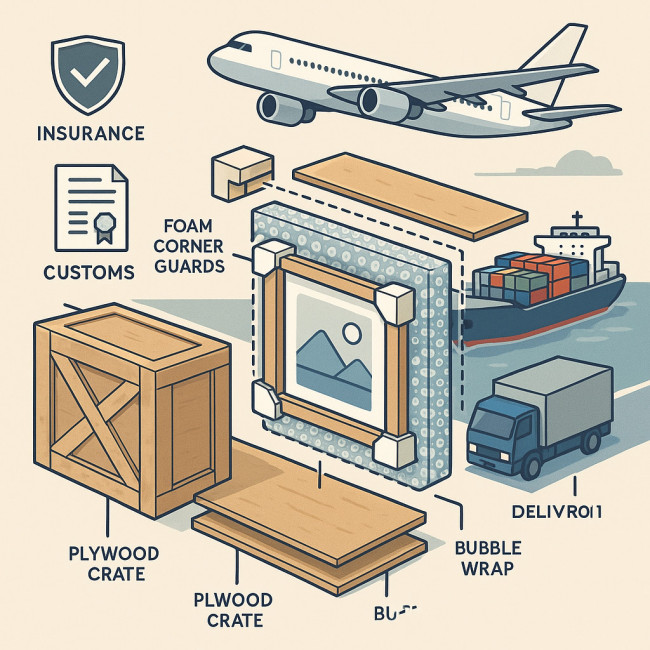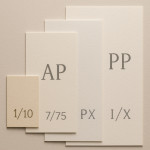Shipping framed prints worldwide: packaging layers, insurance and duties
Sending a framed print from your studio to a collector in another country involves more than popping it in a box and hoping for the best. You need the right multilayer packaging, the correct insurance cover and a solid understanding of customs duties. Follow this guide to reduce breakage risk to near-zero, avoid surprise fees and protect both your art and your reputation.
Why shipping framed prints is different from regular parcels
Framed artworks combine fragile glass or acrylic, exposed corners and a high declared value. Couriers therefore treat them as “non-conveyable” items: packages that travel by hand rather than on automated belts. That special handling adds cost and complexity, but it also opens the door to tailored services—if you know what to ask for.
Key pain points
- Impact shock: Sudden vertical drops from belts or vehicles crack glazing and rip backing boards.
- Vibration: Long-haul trucks and air cargo create micro-movements that loosen hanging hardware.
- Humidity swings: Changes between airport tarmacs and cargo holds warp wooden frames.
Packaging layers that survive long-haul transit
Use at least four protective layers. Skipping one shifts stress to the next, increasing breakage odds exponentially.
Layer 1 – Surface sleeve
- Place the glazed face into a polyethylene sleeve or acid-free glassine.
- Purpose: stops dust scratches and prevents tape residue on glazing.
Layer 2 – Corner and edge guards
- Slide foam corner protectors onto all four corners; add frame-edge U-channels if the moulding is ornate.
- Tip: Re-use corner guards from ready-made frames—collect them in advance to cut costs.
Layer 3 – Shock-absorbing wrap
- Wrap the entire frame with 3 cm bubble wrap (large bubbles outward) and secure with painter's tape.
- Add a second criss-cross wrap for prints larger than 70 × 50 cm.
Layer 4 – Rigid sandwich
- Cut two double-wall cardboard sheets 5 cm larger than the frame on all sides.
- Clamp the wrapped frame between the sheets using pallet straps or kraft tape.
Layer 5 – Exterior carton or crate
- Pick a triple-wall corrugated carton for prints under 6 kg.
- Choose a plywood art crate with foam lining for heavier or high-value work.
- Add “This side up” and “Glass” pictograms on two adjacent faces.
Need a deeper dive into packing fragile glazing? Our specialist glass-packing checklist explains foam densities and drop-test standards.
Carrier comparison: liability limits and art insurance options
| Courier | Standard liability (USD) | Special art cover available | Max girth + length |
|---|---|---|---|
| UPS | $100 | UPS Capital® Fine Art | 419 cm |
| DHL Express | $100 | DHL SecureLine Art | 300 cm |
| FedEx | $100 | FedEx Declared Value Advantage | 330 cm |
| Local fine-art forwarder | $0 (full-value insurance mandatory) | Included in service fee | Custom |
Standard liability rarely covers the sale price of an editioned print, so step up to specialist insurance. If you already follow the art-work insurance safeguards used for sculptures, you're halfway there.
How to declare value correctly
- Use your invoice amount or current gallery retail price—whichever is higher.
Insurance underwriters judge claims on market value, not sentimental attachment. - Add packing cost to the declared value if you want materials reimbursed after damage.
- Check that the courier's claim deadline (often 21 days) matches your customer service policy.
Customs duties and taxes made simple
HS codes and descriptions
Most framed prints ship under HS code 9702.00.00 “Original engravings, prints and lithographs.” Many countries waive import duty on this code but still apply VAT or GST.
Three scenarios you'll meet
- Artwork sold internationally
- The buyer becomes the importer of record. Use Delivered At Place (DAP) terms, list the sale price, and let them handle local VAT.
- Consignment to a gallery
- Ship under a temporary import or “bond.” Declare “value for customs only” and ensure the gallery re-exports the work or pays duties when sold.
- Replacement or warranty shipment
- Mark as “warranty replacement – no commercial value.” Include the original import documentation to avoid double taxation.
For a complete duty-free export roadmap, adapt the jewellery workflow: the same ATA Carnet principles apply to art prints.
Booking the right service: cost vs. peace of mind
Three carrier tiers
- Standard courier (2–7 days): Cheapest, but minimal liability. Suitable for prints below $300.
- Express courier with art add-ons (1–3 days): Balanced option for mid-range editions.
- Fine-art shipper: White-glove packing, climate-controlled trucks and onsite condition reports. The only viable route for museum-grade pieces.
Price benchmarks for a 60 × 40 cm framed print, 5 kg, New York → Berlin
- Standard courier: ≈ $160
- Express + art insurance: ≈ $250
- Fine-art shipper: ≈ $520
Yes, specialist services cost more up front, but they often include zero-deductible insurance and offer climate control that prevents hidden damage—a selling point you can highlight on your professional image-designer profile.
Pre-shipment checklist
- Document condition: Photograph front, back and edges before packing.
- Number layers: Attach a packing diagram inside the carton for customs inspectors.
- Add moisture control: Two 15 g silica-gel packets per cubic foot of interior space.
- Include paperwork: Commercial invoice, certificate of authenticity and any CITES permits if your frame contains exotic wood.
- Send tracking early: Email the buyer a tracking link and insurance certificate within two hours of pickup.
Worried about prototypes or one-off test prints? Combine this checklist with risk-free sample agreements so you're covered contractually as well.
Unboxing instructions for the buyer
Slip a one-page sheet under the outer flap. Include:
- Illustrated cutting guide (avoid blades deeper than 12 mm).
- Warning to film the unboxing for insurance evidence.
- Return-handling steps if exterior damage is visible.
Common mistakes and how to avoid them
- Using single-wall cartons
- Compression forces in cargo holds exceed 30 kg per square centimetre—single wall collapses.
- Shipping with glass instead of acrylic
- Glass is heavier and shatters; museum-grade acrylic meets UV specs and resists breakage.
- Under-declaring value to save duties
- Insurance will only reimburse the declared amount. You lose twice: lower payout and possible customs fines.
Mini-quiz: Are you shipment-ready?
FAQ
- Can I ship multiple framed prints in one crate?
- Yes, but separate each print with 5 cm foam spacers and ensure the combined weight stays within the crate's dynamic load rating.
- Do I need an ATA Carnet for art fairs?
- For temporary exhibits, a Carnet speeds border crossings and avoids paying duties twice, but it is optional if your prints are sold DAP.
- Is acrylic glazing accepted by high-end collectors?
- Museum-grade acrylic with a hard coat and UV protection is widely accepted and dramatically lowers breakage risk.
- What if the buyer refuses to pay import VAT?
- Use DAP terms to make the buyer responsible; if using DDP, build VAT into your price and pre-pay it through your courier's broker.
- How long should I keep packing photos?
- Store them for at least 18 months—the typical statute of limitations for international insurance claims.
Take the next step

Now that you know how to package, insure and document duties, integrate these standards into your studio SOP and update your artwork listings today. When collectors see “museum-grade shipping included,” conversion rates soar. Ready to ship your next framed print with confidence? Put the checklist above into action and watch damages—and stress—drop to zero.











